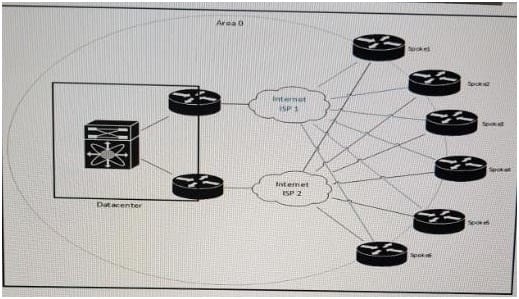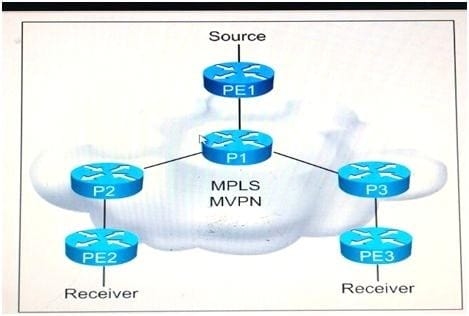Exam Details
Exam Code
:352-011Exam Name
:Cisco Certified Design Expert PracticalCertification
:Cisco CertificationsVendor
:CiscoTotal Questions
:249 Q&AsLast Updated
:Apr 11, 2025
Cisco Cisco Certifications 352-011 Questions & Answers
-
Question 111:
Which two application requirements are mandatory for traffic to receive proper treatment when placed in the priority queue? (Choose two)
A. WRED drop treatment
B. Small transactions (HTTP ?like behavior)
C. Tolerance to packet loss
D. Intolerance to jitter
E. TCP based application
-
Question 112:
Which effect of designing a Layer 2 network using the PortFast fast feature with PVST+ is true?
A. It shuts down the port when receiving the superior BPDU
B. It accelerates the network convergence on the trunk uplinks
C. In combination with BPDU filtering, it causes the switch port to stay in the forwarding state
D. It moves the switch port directly to the forwarding state
-
Question 113:
Which three different behaviors must a network designer expect when bidirectional PIM is used instead of PIM Sparse Mode? (Choose three)
A. The source IP addresses from the multicast senders cannot be seen in the multicast routing table
B. The RPF check does not prevent routing loops when bidirectional PIM is used
C. Many possible rendezvous point can be used for bidirectional PIM as compared to PIM Sparse Mode
D. PIMv2 BSR is not supported with bidirectional PIM
E. The join messages to join a bidirectional PIM multicast group are different compared to PIM-SM
F. No rendezvous point is required when bidirectional PIM is used
G. Auto-RP is not supported with bidirectional PIM
-
Question 114:
A Mobile Service Provider would like to design and deploy an Ethernet service which has similar physical link failover/failback characteristics on the active/backup links as the APS/MSP SONET properties. Which Layer 2 service addresses should be considered to address this design feature?
A. Port-Channel
B. MLPPP
C. Flex Link
D. Ethernet Pseudowire
-
Question 115:
Which mechanism does OSPF use to prevent loops in an MPLS Layer 3 VPNS environment?
A. Sham link
B. Down bit
C. P-Bit
D. Domain ID
E. Routing bit
-
Question 116:
A healthcare customer requested that health statistics from their infrastructure devices are to be sent over their service provider MPLS network. Which protocol must be enabled?
A. SNMPv3
B. Syslog TLS
C. syslog
D. SNMPv2
E. SSH
-
Question 117:
Refer to the exhibit.

You must review this single OSPF area, DMVPN network because the company has noticed a few area 0 convergence and stability issues. Also, traffic destined to the data center from one of the spokes as the next hop on the path. The company prefers that all traffic destined to the data center uses the least amount of hops. Which solution resolves these issues with the minimum amount of changes on the network?
A. Migrate from OSPF to static routes between the hub routers and the spoke routers and deploy IP SLA for route health checks
B. Migrate from OSPF to EIGRP between the hub routers and the spoke routers
C. Modify OSPF cost metrics on all backup links
D. Create areas between each hub and their spoke routers, to ensure that the hub routers become DRs
-
Question 118:
For a redesign requirement of the service provider network, summarization was implemented at multiple locations for each summary range. Now some customers of the service provider are complaining of higher latency and performance issues for a server hosted in the summarized area. Which design issues must be considered when creating the summarization?
A. Summarization adds CPU overhead on the routers sourcing the summarized advertisement.
B. Summarization prevents the visibility of the metric to the component subnets.
C. Summarization causes packet loss when RPF is enabled.
D. Summarization creates routing loops.
-
Question 119:
Refer to the exhibit.

You are a network designer who is given these design requirements: Multicast services must be provided for Layer 3 VPN customers The same forwarding technology must be used as Layer 3 VPN unicast packets Replication of multicast traffic is not allowed on the ingress PE Which multicast VPN technology conforms to the design requirements?
A. Multipoint-to-point LDP
B. MSDP
C. MLDP VPN
D. Rosen Draft using LDP
-
Question 120:
An ISP provides VoIP and internet services to its customers. For security reasons, these services must be transported in different MPLS Layer 3 VPNs over the ISP core network. The customer CEs do not have the ability to segment the services using different VLANs and have only one uplink interface that does not support VLAN tagging. How should you design the network to ensure that VoIP traffic that is received from the CE goes in the VoIP VPN, and that Internet traffic goes into the Internet VPN on the ISP PE devices?
A. Use a secondary interface IP address to differentiate between VoIP and Internet traffic
B. Extend the Layer 3 VPN toward the CE
C. Enable NBAR on the PE to direct the traffic into the correct VRF
D. Use a subinterface on the PE for each service, VoIP and Internet, with different subnets
E. Use policy-based routing to direct traffic into the correct VRF
Related Exams:
300-915
Developing Solutions using Cisco IoT and Edge Platforms (DEVIOT)300-920
Developing Applications for Cisco Webex and Webex Devices (DEVWBX)352-011
Cisco Certified Design Expert Practical500-052
Cisco Unified Contact Center Express500-173
Designing the FlexPod Solution (FPDESIGN)500-174
Implementing and Administering the FlexPod Solution (FPIMPADM)500-201
Deploying Cisco Service Provider Mobile Backhaul Solutions500-210
SP Optical Technology Field Engineer Representative500-220
Cisco Meraki Solutions Specialist500-230
Cisco Service Provider Routing Field Engineer
Tips on How to Prepare for the Exams
Nowadays, the certification exams become more and more important and required by more and more enterprises when applying for a job. But how to prepare for the exam effectively? How to prepare for the exam in a short time with less efforts? How to get a ideal result and how to find the most reliable resources? Here on Vcedump.com, you will find all the answers. Vcedump.com provide not only Cisco exam questions, answers and explanations but also complete assistance on your exam preparation and certification application. If you are confused on your 352-011 exam preparations and Cisco certification application, do not hesitate to visit our Vcedump.com to find your solutions here.